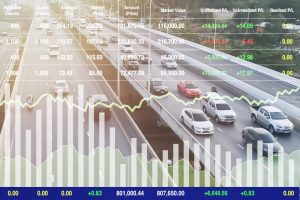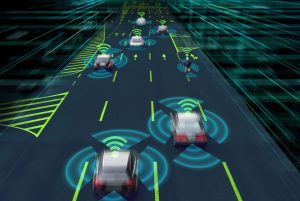The logistics industry, which is one of the biggest customers for the commercial vehicle OEMs, is currently facing a difficult situation with a lot of urgent problems. The commercial vehicle OEMs are attempting to contribute to solving this industry’s problems through the promotion of CASE. Regarding the Connected domain in particular, there are some leading companies that have started working on these issues relatively early, and consequently there are already some practices with clear business outcomes , and references to be benchmarked for the future mobility. I would like to study those best practices in the Commercial Vehicle Connected domain, find out and share the key success factors.
Issues which the logistics industry is facing
In the logistics industry, the following old and new problems have been visible for a long time.. Despite the spread of E-commerce and the increased societal need for logistics, the industry is stagnating.
- More frequent deliveries of smaller lots of parcels: This tendency has leveled off in recent times, but as a long term trend, the volume per delivery has shown decreasing, while the number of deliveries has increased
 Source: “The Present State of Distribution” MLIT October 2018
Source: “The Present State of Distribution” MLIT October 2018
- A decreasing loading efficiency per truck : Recently, the loading efficiency per truck has dropped to around 40%
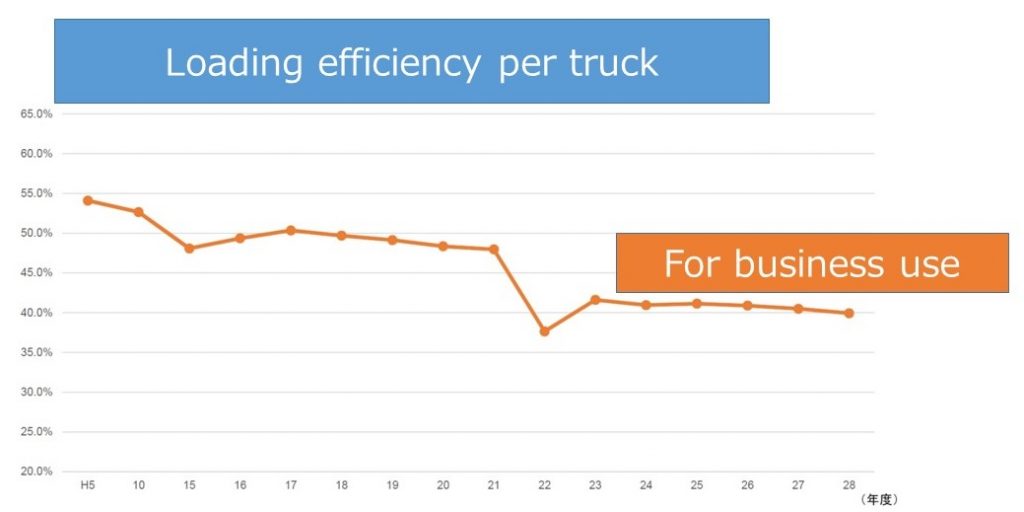
*Loading efficiency = Transport ton kilometers/performance ton kilometers
Source: “The Present State of Distribution” MLIT October 2018
- Lack of manpower: The number of logistics companies that are suffering from the shortage of truck drivers has been increasing every year, and the outlook for the future is not bright
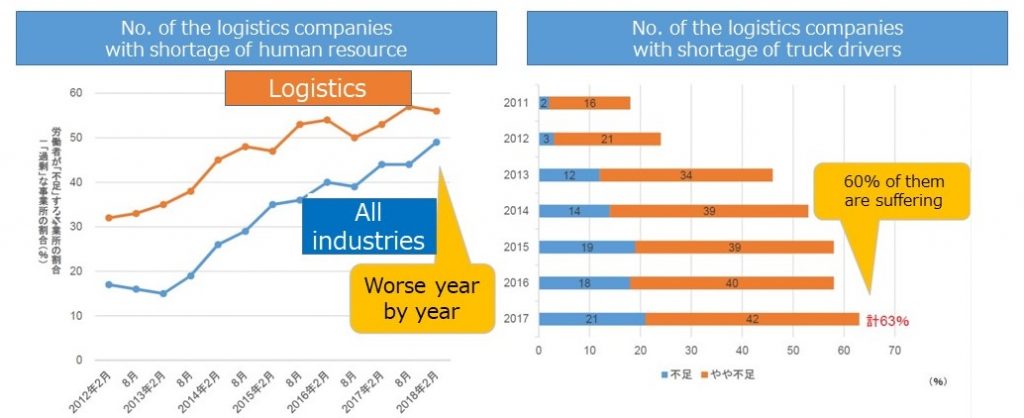
Source: “The Present State of Distribution” MLIT October 2018
Source: “Outlook of the Truck logistics Industry” Japan Trucking Association August 2019
Use cases of Connected trucks
This section will introduce a certain commercial vehicle manufacturer that is leveraging the idea of “Connected” and machine learning to not only increase the operation efficiency of their customers facing the above-mentioned issues in the previous section, but also improve the productivity of their dealers’ service workshops.
Use case of automated vehicle failure identification
- Background:
-
There is a need to improve productivity and skills in service shops due to the lack of manpower, in particular because of the retirement of skillful veteran mechanics. In order to identify the failures with vehicles precisely and efficiently, experienced mechanics need to analyze the complicated sensor data with many parameters and identify the problematic parts needing replacement. However, it is not so easy to carry on this skill and knowledgeto younger mechanics.
- System mechanism (summary):
-
This is an automated vehicle failure identification system using the vehicle’s sensor data triggered the malfunction. This system predicts the necessary repair work and vehicle parts based on the data before the vehicle enters the shop and attempts to decrease the downtime needed to identify the failureand improve productivity. utilizing machine learning to realize high precision.
<Summary image>
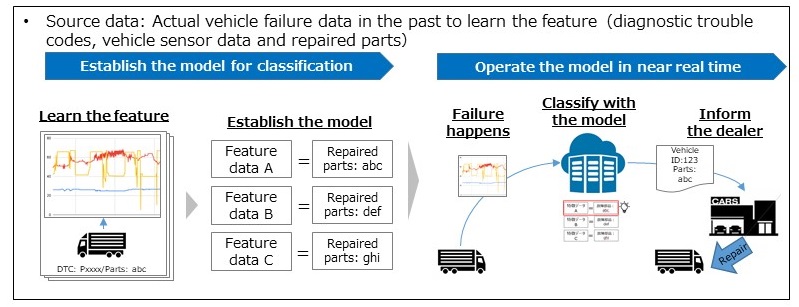
- Business outcome
Through the decreased time required for the vehicle to be in the service shop, the amount of downtime for the customer’s vehicle is reduced/the amount of uptime is increased, and consequently the operation efficiency of these customers is improved. This system is also evaluated positively by the dealers.
- The other opportunity of using vehicle sensor data
Combining and storing vehicle sensor data with other business data, and analyzing to capture the whole picture for the problems and causal relationships usually requires large workload with unique skill and knowledge. However, there is the possibility that important expertise, that is currently tacit knowledge limited to only certain experienced members, will be shared with more relevant people in the organization. For example, by combining and analyzing customers’ vehicle sensor data with service parts shipping data and field quality information, it will become easier to learn the relationship between the customer’s vehicle usage and the demand for service parts, as well as quality problems. It will also become easier to optimize the design of the vehicle’s performance and specifications.
Study key success factors
- Gathering, integrating, and accumulating past related data
In order to construct a high precision model that uses machine learning as mentioned in the previous section, a large amount of past data is necessary. Furthermore, it is necessary to combine a variety of different types of data with some key and analyze it, as using homogenous data makes it impossible to clarify causal relationships and improve precision. - Coordination and reconciliation among various stakeholders inside and outside the company with understanding by senior management
In order for not just a proof of concept but eventually realizing the operational system in practice, it is necessary to integrate and harmonize the expertise of IT and data science experts, as well as operational business members who have insights of the relevant work areas. Last but not least, this type of project will involve many stakeholders from inside and outside the company over several months in minimum, so the understanding and leadership by the management, can’t be over-emphasized.




